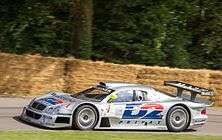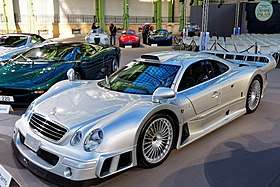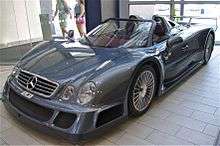Mercedes-Benz CLK GTR
 | |||||||||
| Category |
Le Mans GT1 FIA GT1 | ||||||||
|---|---|---|---|---|---|---|---|---|---|
| Constructor | AMG-Mercedes | ||||||||
| Successor | Mercedes-Benz CLR | ||||||||
| Technical specifications | |||||||||
| Chassis | Carbon fibre and aluminium honeycomb monocoque | ||||||||
| Suspension (front) | Double wishbone suspension | ||||||||
| Suspension (rear) | Double wishbone suspension | ||||||||
| Length | 4,855 mm (191 in) | ||||||||
| Width | 1,950 mm (77 in) | ||||||||
| Height | 1,100 mm (43 in) | ||||||||
| Axle track |
1,610 mm (63 in) (front) 1,650 mm (65 in) (rear) | ||||||||
| Wheelbase | 2,670 mm (105 in) | ||||||||
| Engine |
GTR: Mercedes-Benz LS600(GT 112)[1] 6.0 L (370 cu in) V12 LM: Mercedes-Benz GT108B 5.0 L (310 cu in) V8 [2][3][4][5] Naturally Aspirated Mid, Longitudinally mounted | ||||||||
| Transmission | 5-speed sequential manual | ||||||||
| Weight | 1,005 kg (2,216 lb) | ||||||||
| Fuel | Mobil high performance 96-octane pump-gasoline[6] | ||||||||
| Tyres | Bridgestone | ||||||||
| Competition history | |||||||||
| Notable entrants |
| ||||||||
| Debut | 1997 FIA GT Hockenheim 4 Hours | ||||||||
| |||||||||
| Teams' Championships | 2 (1997 FIA GT, 1998 FIA GT) | ||||||||
| Drivers' Championships | 2 (1997 FIA GT, 1998 FIA GT) | ||||||||
The Mercedes-Benz CLK GTR (W297) is a sports car and race car that was built by Mercedes-AMG, performance and motorsports arm of Mercedes-Benz. Intended for racing in the new FIA GT Championship series in 1997, the CLK GTR was designed primarily as a race car, with the road cars necessary in order to meet homologation standards being secondary in the car's design. Thus the limited production road-going cars are considered racing cars for the road.
After competing successfully in 1997, the race car was upgraded in 1998 for the 24 Hours of Le Mans and renamed the CLK LM. Following the construction of the CLK LMs and the CLK GTR road cars, the project would end in 1999 by being replaced by the Mercedes-Benz CLR Le Mans prototype.
Racing car
CLK GTR
.jpg)
As the Deutsche Tourenwagen Meisterschaft/International Touring Car Championship had folded in late 1996, with both remaining competitors Opel and Alfa Romeo leaving due to the high costs of their 4WD designs, Mercedes-Benz had no top series to compete in. With the success of the BPR Global GT Series leading to the FIA taking over and turning it into an international series known as the FIA GT Championship, Mercedes-Benz saw an opportunity to go against manufacturers like Porsche and Ferrari.
Following the design that Porsche had laid out with their 911 homologation special, the GT1, Mercedes-AMG was tasked by Mercedes-Benz with creating an extreme racing car that still maintained some elements of a normal street legal car. AMG's designers created a car which shared some design elements with the Mercedes-Benz CLK, yet had all the standard features of a racing car underneath. A Mercedes-Benz M120 V12 engine would be at the heart of the car, mounted behind the cockpit. The bodywork would be made entirely of carbon fibre, and would feature many aerodynamic design elements and cooling openings in order to survive on the race track.
To test the CLK GTR before the first chassis were built, Mercedes-AMG actually took an unusual measure. Through secrecy, Mercedes-AMG was able to purchase a disused McLaren F1 GTR, the defending BPR GT series champion, from Larbre Compétition. This purchase first allowed Mercedes-AMG to see the kind of lap times that their competitors could run, to serve as a measurement of the CLK GTR's abilities. However, more importantly, Mercedes-AMG set about modifying this F1 GTR by attaching bodywork that was meant to go on the CLK GTR. Mercedes-Benz also used their own LS600 6.0 liter V12 engine in place of the BMW V12 unit.[7] This allowed Mercedes-AMG to be able to perfect the aerodynamics of the car before it had even been built.
Upon completion of the first two prototypes a mere 128 days after the initial drawings had been made, the CLK GTRs were entered into the 1997 FIA GT Championship season, debuting at the season-opener at one of Mercedes-Benz's home tracks, the Hockenheimring. Unfortunately the new cars were not able to shine, as brake problems eliminated one car after five laps, and the other finished over 20 laps behind the winning McLaren. However, by the next round at Silverstone, the CLK GTR began to show its pace, finishing less than a second behind the winning McLaren. By the fourth round, returning to Germany for the Nürburgring, a third CLK GTR was added to the team. In this race, Mercedes-Benz successfully outperformed the fleet of McLarens, taking first and second places. The team would finish out the season with five more wins, at A1-Ring, Suzuka, Donington, Sebring, and Laguna Seca, allowing them to secure the team championship as well as the drivers championship for Bernd Schneider.
Mercedes-Benz would use the CLK GTR for the first two rounds of the 1998 season before upgrading to the CLK LM. However privateer team Persson Motorsport would campaign two CLK GTRs throughout the entire season, taking a best finish of second at Oschersleben before finishing the year third in the teams championship.
Initially the CLK-GTR's V12 engine produced approximately 600 hp (450 kW) and 538 lb⋅ft (729 N⋅m) of torque.
CLK LM

After conquering the FIA GT Championship, Mercedes-Benz set its sights on competing at the 24 Hours of Le Mans in 1998, which it had not been at since 1991. However, Le Mans presented a different challenge from that offered in FIA GT, in that the race distances were nearly one tenth the distance covered at Le Mans. Therefore, Mercedes-AMG set about altering the CLK GTR in order to meet the new demands required at Le Mans.
First and foremost, Mercedes-AMG decided that the M120 V12 would not be up to the task of running for 24 hours. Instead, they decided to use the M119 HL V8 engine from Sauber C9/Sauber C11 which raced in the late 1980s and early 1990s, as Mercedes-AMG felt that the M119HL would have better reliability at speeds while still performing the same amount of power as the M120 due to air restrictor regulations. The turbochargers were removed and other revised components were added in order to achieve high rpm.[8] The modified engine was designated as GT108 B.
Satisfied with the engine, Mercedes-AMG also set about altering the bodywork to better cope with the high speeds of Le Mans. The nose was lowered and the large front brake cooling ducts on the sides of the nose were removed and replaced by a single, large opening in the front of the car. The roof of the car was also lowered and a new engine air intake was designed for better engine cooling along with various other mechanical tweaks. This new car would become known as CLK LM, with the LM designation standing for Le Mans.
Debuting at the 1998 season of Le Mans, the twin CLK LMs entered were immediately quick. The two car team took the pole, ahead of custom built open cockpit Le Mans prototypes. However, Mercedes-AMG's belief of the M119LH engine's reliability and capability was proven wrong as both cars suffered engine failures within the first few hours of the race, leaving Mercedes-Benz dejected.
Returning to FIA GT, Mercedes-Benz replaced their older CLK GTRs with the new CLK LMs and saw greater success. The two cars easily won every remaining race, including six 1-2 finishes. This handed Mercedes-Benz the teams championship again, while Klaus Ludwig and Ricardo Zonta would share the drivers championship.
For the 1999 season, no competitor attempted to enter the GT1 class in FIA GT except for Mercedes-Benz, forcing FIA to cancel the class, similar to the DTM/ITC two years earlier. Mercedes-Benz thus turned to constructing an all-new car to overcome their failure at Le Mans. No longer forced to build a racing car that could also be a road car, Mercedes-AMG set about creating the Mercedes-Benz CLR.
The CLK LM's V8 engine produced approximately 600 hp (608 PS; 447 kW), allowing it to reach speeds up to 330 km/h (205 mph) in testing for the 1998 24 Hours of Le Mans disregarding a claimed virtual top speed of 335 km/h (208 mph). In total, five CLK-LMs were constructed, with one test car for crash testing and subsequently written off, one road-going version was built to comply with the 1998 FIA regulations, and three race versions were constructed. Chassis #005 was sold by Mercedes AMG to a private collector in Japan after the 1998 season and has since changed ownership, but remains in private hands along with the road-going version.[9]
Road car
| Mercedes-Benz CLK GTR Straßen Version | |
|---|---|
 | |
| Overview | |
| Manufacturer |
Mercedes-Benz (Mercedes-AMG in collaboration with HWA AG) |
| Production |
1998–1999 (30 produced) 2 prototypes 20 coupés[10] 6 roadsters[11] |
| Assembly | Affalterbach, Germany |
| Body and chassis | |
| Class | Sports car (S) |
| Body style |
2-door coupé 2-door roadster |
| Layout | rear mid-engine, rear-wheel-drive |
| Powertrain | |
| Engine | 6.9 / 7.3 L (6,898 / 7,291 cc) M297 V12 |
| Power output |
612 PS (450 kW; 604 hp) 775 N⋅m (572 lbf⋅ft) of torque |
| Transmission | 5-speed sequential manual |
| Dimensions | |
| Wheelbase | 2,670 mm (105 in) |
| Length | 4,854 mm (191 in) |
| Width | 1,951 mm (77 in) |
| Height | 1,102 mm (43 in) |
| Curb weight | 1,440 kg (3,175 lb) |
| Chronology | |
| Predecessor | Mercedes-Benz C112 (spiritual) |
| Successor | Mercedes-AMG One |
Even though the FIA GT1 class was cancelled for 1999, Mercedes was obliged to finally deliver the required minimum 25 road cars they had promised per FIA rules. An initial road car was built in 1997 in order to meet initial FIA requirements, but this car was retained by Mercedes. For the other road cars, each was built by AMG at the Affalterbach factory between winter of 1998 and summer of 1999 and differed only slightly from the race car. All of the 26 production cars ever built were left hand drive except for two, a coupé and a roadster, which were specially built for Sultan Hassanal Bolkiah of Brunei. Driver comfort and refinements were at a minimum in the construction of the road cars as Mercedes-Benz wished to not only offer customers a true race car, but also to attempt to keep the price low. Leather was used in the interior and an air conditioning system was offered. Two small storage lockers were also built underneath each upward swinging door (gull-wing door). Traction control was also added for driver safety.
The road car retained much of the design of the original CLK GTR instead of the CLK LM, including the V12 engine and many stylistic elements. One key difference was the rear wing, which used a hoop-style integrated wing in place of the separate racing wing. From the otherwise unrelated standard production Mercedes-Benz CLK, only the instrumentation, front grille,rear lights and the four headlamps were used.
Ilmor Engineering provided enhancements to the engine, increasing displacement from 6.0 L (5,987 cc) to 6.9 L (6,898 cc), once stroked up to 92.4 mm (3.64 in). This increase in displacement coupled with the removal of a racing air restrictor allowed for 612 PS (450 kW; 604 hp) at 6,800 rpm and torque to 775 N⋅m (572 lb⋅ft) at 5,250 rpm. Mercedes-AMG claimed a 0–100 km/h (0–62 mph) acceleration time of 3.8 seconds and a top speed of 344 km/h (214 mph).
The Guinness Book of World Records recorded the CLK GTR as the most expensive production car ever built at the time, with a price of $1,547,620(USD).
Two road car prototypes were manufactured and do not have a numbered plaque that the subsequent production cars all wear on the door sills and center console. These prototypes wear a plaque simply with the label "Limited Edition." The second prototype, VIN WDBA2973971Y000002, was auctioned in 2003 by Bonhams for 800,000 Euros.[12] Twenty coupés were made separate from the pre-production cars and each have a serial number labeled 01/25 through 20/25. No coupés were manufactured with the numbers 21/25 through 25/25. Instead, these numbers represented the initially planned five roadsters (an additional sixth roadster was made by the end of production). While most of the coupes are painted silver, chassis #19 has a dark blue paint scheme while #20 has a black paint scheme. Chassis #17 was formerly painted red and was repainted in silver when sold by Ferrari of Fort Lauderdale.[13] Prototype #1 and production cars bearing chassis number #05, #07, and #13 have tartan interiors.
Two of the 26 cars produced were equipped with RHD steering: one coupé (chassis number #13, silver exterior/tartan interior) and one roadster (chassis number #2, dark silver exterior/magenta interior).[14] These were constructed for Hassanal Bolkiah, the Sultan of Brunei.[15] Both RHD cars were auctioned on 28 October 2009 by RM Auctions in London.[16] The roadster fetched £616,000 ($973,834 USD) and the coupe £522,500 ($824,609 USD).[17]
CLK GTR Roadster

After the completion of the 20 original CLK GTRs, AMG's specialist group H.W.A., who had assisted in the construction of the CLK GTRs, began construction of a roadster version of the CLK GTR. Built either by modifying an existing CLK GTR or by building a new car from spare chassis and parts, these cars were modified with the removal of their roofs as well as a reconstruction of their engine covers. Additionally, the rear wing was replaced by a separate black wing, close to the one on the racing version of the CLK GTR. Further, the Roadster can be recognized by its different front grille, which had a large three-pointed star in it instead of a small version above it. Two rollbars integrating the cockpit headrests were used not only for structural integrity, but also for rollover protection. A total of 6 CLK GTR Roadsters were built by the company. Roadster chassis #1 was the only roadster painted in black and #2 was painted dark silver with a magenta interior. The remaining four were painted silver and have various interior colors.
CLK GTR Super Sport
H.W.A. also constructed a second variant, known as the CLK GTR Super Sport. These cars were similar to CLK GTRs, yet were powered instead by the newer Mercedes-AMG 7.3L V12 which had been in use in the Pagani Zonda and Mercedes-Benz SL73 AMG. Producing 664 PS (488 kW; 655 hp) and 786 N⋅m (580 lb⋅ft) of torque. The car also gained an additional front splitter for better stability at high speeds. Only 5 were built with the 7.3-litre engine: prototype #2, chassis number #01, #03, #13, and #17.
See also
References
- ↑ "- marsMediaSite". MarsMediaSite. Retrieved 4 December 2017.
- ↑ "1998 Mercedes-Benz CLK-LM Specifications". Ultimatecarpage.com. Retrieved 4 December 2017.
- ↑ "120 years of motor sport at Mercedes-Benz take centre stage at the Goodwood Festival of Speed 2014 - marsMediaSite". MarsMediaSite. Retrieved 4 December 2017.
- ↑ "Charles Queguiner : Le Mans 1998". Charles.queguiner.free.fr. Retrieved 4 December 2017.
- ↑ "Le Mans 24 Hours 1998 - Car Data & Information - Racing Sports Cars". Racingsportscars.com. Retrieved 4 December 2017.
- ↑ Dennis Simanaitis and Steve Millen (4 March 2016). "Driving the Championship winning CLK-GTR". road and track. Retrieved 22 March 2018.
- ↑ Máté Petrány. "The Original Prototype For The Mercedes CLK-GTR Was A McLaren F1 GTR". Jalopnik.
- ↑ "C9/C11 Suaber & The CLK-LM ?". 500eboard.com. Retrieved 4 December 2017.
- ↑ https://www.classicsportleicht.com/en/Cars/Sold/1998-Mercedes-Benz-CLK-LM-FIA-GT1-World-Champion-car/4
- ↑ "2002 Mercedes Benz CLK GTR roadster". Thecarexperience.com. Archived from the original on 2009-08-06. Retrieved 2009-08-07.
- ↑ "2002 Mercedes-Benz CLK-GTR Roadster for sale". Anamera. Retrieved 2009-08-07.
- ↑ https://www.ultimatecarpage.com/chassis/2687/Mercedes-Benz-CLK-GTR-Coupe-WDBA2973971Y000002.html
- ↑ https://www.maseratifl.com/used/MERCEDES-BENZ/2000-MERCEDES-BENZ-AMG+CLK+GTR-Fort+Lauderdale-18de0df20a0a00de00438935560b8f73.htm
- ↑ "Ss United Trading Ltd". Ss-united-trading.org. Archived from the original on 2009-04-21. Retrieved 2009-08-07.
- ↑ "Mercedes Benz CLK-GTR - the Unique RHD versions | Cars UK | UK Car News". Cars UK. 2009-02-13. Retrieved 2009-08-07.
- ↑ "Two CLK GTRs Fall Under The Hammer | PistonHeads". Haymarket. 2009-09-24. Retrieved 2009-09-24.
- ↑ "RM AUCTIONS ROUNDS OUT 2009 WITH IMPRESSIVE RESULTS IN LONDON". RM Auctions. Retrieved 2009-11-12.
External links
| Wikimedia Commons has media related to Mercedes-Benz CLK GTR. |